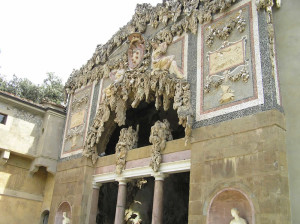Questo articolo è disponibile anche in:
![]() Français
Français ![]() Deutsch
Deutsch ![]() Español
Español ![]() Italiano
Italiano
The Buontalenti Grotto was built, designed and conceived between 1583 and 1593 by Bernardo Buontalenti (Florence 1536-1608). This Grotto is one of the most important places in the Boboli Gardens, it is an artificial cave filled with false stalactites and stalagmites, with statues of sheep, shepherds and Roman gods. Buontalenti Grotto represents one of the most valuable examples of Mannerist architecture in the city.
A MASTERPIECE OF MANNERISM
The facade is a work of Giovanni Battista del Tadda, flanked by statues of Ceres and Apollo by Baccio Bandinelli. It is surmounted by the Medici coat of arms and by the two figures representing “peace” and “justice”.
The origins of the Medici coat of arms, whose design was changed several times over the years, are not known. The ball on the top is blue and is painted with the lilies of France. This is in accordance with the privileges received by the king of France Louis XI in exchange for the diplomatic services received. The emblem of the Medici family, a number of red balls on a golden shield, is displayed on many buildings in Florence and Tuscany.

The Buontalenti Grotto is formed by a series of three communicating chambers. The first chamber, with stuccowork decorations work by Pietro Mati, is characterised by pastoral scenes executed by Bernardino Poccetti (1542-1612). This chamber sheltered until 1924 the “Prigioni” of Michelangelo (now at the Galleria dell’Accademia, in the cave are copies).
The second chamber contains a marble statue group depicting the abduction of Paride and Elena, sculpted by Vincenzo Rossi da Fiesole (1525-1587). The third chamber, frescoed by Poccianti, has a fine fountain by Giambologna (Douai 1529-Florence 1608) depicting Venere al Bagno (Venus emerging from the water after bathing) threatened by four satyrs.
This Grotto is located close the entrance of the Boboli Garden and in the point where the Vasari Corridor ends.

BERNARDO BUONTALENTI
Bernardo Buontalenti (Florence 1536-1608) was an architect, sculptor, painter, miniaturist and military engineer, he was one of the protagonist of the Tuscan architecture in the 16th century. As superintendent of the civil and military factories in the Grand Duchy, he oversaw the fortifications of Florence, Prato, Leghorn, Pistoia, Grosseto, Siena and Elba Island.
Buontalenti also invented war equipment, mechanical instruments, automatons and ingenious devices for the entertainment of guests. His most important works include the villa and the garden of Pratolino, the contribution to the construction of the Uffizi, the Grotto in the Boboli Gardens. Then he worked on the Belvedere Fortress and the villas of Artiminio and Cerreto Guidi. Finally his work was important in Poggio a Caiano, and at the port of Livorno.
Questo articolo è disponibile anche in:
![]() Français
Français ![]() Deutsch
Deutsch ![]() Español
Español ![]() Italiano
Italiano







